Michael J. Roueche's Blog
June 17, 2017
Indie Book Award Honors “Tempting Skies”

I’m grateful to note that Tempting Skies, Beyond the Wood Book 3, has been named one of the best indie books of 2017 by the Independent Book Publishing Professionals Group (IBPPG).
The group formalized the recognition by naming the Civil War novel a finalist in its 2017 Next Generation Indie Book Awards. The awards were presented May 31 in a ceremony at the Harvard Club in New York City.
Beyond the Wood, the first book in the trilogy, received the same recognition in 2012.
IBPPG promotes “professional standards in independent book publishing (also known as ‘indie’ book publishing), and provide[s] support and recognition for the independent book publishing profession.” (Bold type in original.) Its Next Generation Indie Book Awards is “the largest not-for-profit awards program for independent publishers.”
The competition is co-sponsored by Marilyn Allen, founder and partner in the Allen O’Shea Literary Agency.
Next Generation Indie Book Awards was founded by Catherine Goulet, Co-Chair of the 2017 awards. She indicates the program “has become known as the Sundance of the book publishing world.”
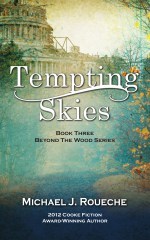 Goulet also said, “Authors and publishers who compete in the Next Generation Indie Book Awards are serious about promoting their books,” adding that “they aim to stand out from the crowd of millions of books in print.” She points out the challenge faced by indies, stating that they “must work harder to get their best books into the hands of readers.
Goulet also said, “Authors and publishers who compete in the Next Generation Indie Book Awards are serious about promoting their books,” adding that “they aim to stand out from the crowd of millions of books in print.” She points out the challenge faced by indies, stating that they “must work harder to get their best books into the hands of readers.
Independent book publishing companies include small presses, larger independent publishers, university presses, e-book publishers and self-published authors.
Tempting Skies has been called, “extraordinary and consistently entertaining.” It continues the story of Virginian Betsy Richman as the Civil War’s devastation trudges southward toward her Shenandoah Valley homestead. Her mother’s one-time slave William Richman, at last a legally free man, painfully struggles to scrape away slavery’s emotional scars and remnant self-doubt, and his strong-willed and intelligent new wife, Victoria, struggles to find meaning in her new life.
I can’t end without thanking the folks at the Next Generation Indie Book Awards for the recognition and support.
The post appeared first on Michael J. Roueche.
March 2, 2017
Chanticleer Book Reviews lauds “A River Divides” as “exceptional in development”

Chanticleer Book Reviews evaluated “A River Divides” because the Civil War novel was a 2014 Laramie Awards category winner.
I’ve been posting too many blogs on reviews and notice of my books lately as reviews have come in following publication of Temping Skies. I apologize for that. I’m committed to writing a “non-self serving” blog in the near future.
But before I turn selfless, I just got notice that Chanticleer Book Reviews, a literary affiliate of the Historical Novel Society, just published a review of A River Divides, the previous book in the Beyond the Wood Series.
I appreciated the attention and review. Chanticleer earlier named the novel a 2014 category winner in its Laramie Awards program which recognizes “emerging new talent and outstanding works” in Western and Civil War fiction.

“A River Divides” was named Best in Category by Chanticleer in its Laramie Awards program.
The review appeared in the March 1, 2017 edition of Chanticleer’s thrice-monthly email highlighting its latest critiques.
The email graciously introduced A River Divides as “Rich in detail and exceptional in development.”
The review itself noted:
Like the first book in Beyond the Woods Series, the second, A River Divides, offers a complex view into life during the Civil War era. . . .
Author Michael J. Roueche does a great job introducing esoteric terms while giving them proper context, thereby helping present-day readers immerse themselves in the historical tapestry he’s created. All the characters in this story demonstrate authentic shades of good and bad, making their choices (and their consequences) even more intriguing.
Reading the first in the series isn’t required here but doing so will certainly enhance the experience.
While the reviewer seemed mildly put off by the shifting points of view (no apologies from me on that point), K. McCoy’s overall conclusion was “Roueche’s beautifully written imagery and ability to immerse readers in place and time will delight and hook readers from the very beginning to the very end.”
Thanks to Chanticleer and K. McCoy.
The post Chanticleer Book Reviews lauds “A River Divides” as “exceptional in development” appeared first on Michael J. Roueche.
February 22, 2017
Civil War News Recognizes “Tempting Skies”
 We’re grateful to Civil War News for including Tempting Skies in its February book section. The paper doesn’t review novels anymore, but it introduced in the February edition a column dubbed Novel Notes, stating that “from time to time we receive works of fiction set in the Civil War era and will occasionally recognize them.” We appreciate the newspaper finding Tempting Skies worth mentioning.
We’re grateful to Civil War News for including Tempting Skies in its February book section. The paper doesn’t review novels anymore, but it introduced in the February edition a column dubbed Novel Notes, stating that “from time to time we receive works of fiction set in the Civil War era and will occasionally recognize them.” We appreciate the newspaper finding Tempting Skies worth mentioning.
I chuckled when I read in the column, after it quoted conflicting dialogue between two people from Tempting Skies: “What I like about Civil War novels is that they offer a forum for characters to argue about the causes and nature of the war in ways that would get the rest of us in trouble with the PC-bosses.”
Writing fiction does allow you to present different perspectives without having to justify why you’re including them. 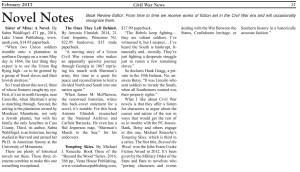 That the feelings and opinions existed provides reason to consider them. In many cases, you don’t need to agree or disagree with statements made. You can leave that to the reader.
That the feelings and opinions existed provides reason to consider them. In many cases, you don’t need to agree or disagree with statements made. You can leave that to the reader.
Historical fiction offers lots of flexibility not granted to nonfiction writers. In the Beyond the Wood Series, I elected to forgo profanity because I didn’t think it important to my purpose, although it was certainly a daily part of the war. I also went to great lengths not to include some derogatory, racially and emotionally charged words for, among other reasons, they raise emotions in me and others that stem from our 20th and 21st century experiences. Of course, racially charged words certainly existed and were hateful, harmful and defining in the 19th Century as well, so I tried to write in a way that implied their odorous existence, especially in A River Divides, Book Two, Beyond the Wood.
For highlighting Tempting Skies, I express thanks to Civil War News and historian Stephen Davis, the publication’s book review editor. Dr. Davis has written several nonfiction books about the war. Check out the Civil War Trust’s worthwhile interview with him about the provocatively titled work What the Yankees Did to Us: Sherman’s Bombardment and Wrecking of Atlanta.
Midwest Book Review Carries Second Review
We also were surprised and glad to see Midwest Book Review carry Teri Davis’s review of the book, which she called “a Civil War masterpiece.” A very kind statement. I didn’t expect Midwest to carry a second review of the book, so I was doubly pleased. Thanks to long-time Midwest Book Review head James A. Cox for his years of service and to Teri for the review.
We appreciate all the support we’ve received from many.
The post Civil War News Recognizes “Tempting Skies” appeared first on Michael J. Roueche.
January 25, 2017
Bestsellersworld.com Praises “Tempting Skies”
 Bestsellersworld.com just posted its review of Tempting Skies.
Bestsellersworld.com just posted its review of Tempting Skies.
Thanks to Teri Davis who reviewed the novel and to Nancy Eaton who manages Bestsellersworld.com. I excerpt portions of the review below. To see more of the review or other books they’ve looked at, visit bestsellersworld.com.
The review starts off with a question:
How would you like to read your ancestors’ journals about their lives while living through the Civil War? Would you be able to understand the perspectives of both sides?
Just recently in the year 2012, while searching through the attic of a mansion in Lexington, Kentucky, scheduled for demolition, a manuscript and letters revealed the history of this estate beginning in the 1820s. These documents are the foundation of the third book of [The Beyond the Wood] trilogy.
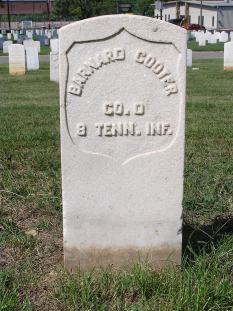
Barnard Cooter Union Grave in Knoxville National Cemetery. Photo courtesy of findagrave.com.
Davis’s introduction reminds me of an unrelated family history experience Susan and I had in the early 2000s. At the time, we were researching Eastern Tennessee family and reached out to people through the Internet. We made contact with a woman who miraculously had a copy of a letter Susan’s fourth great grandfather John Cooter (from the German Kuter), born in 1804 in Virginia, had written to siblings in Missouri touching on his Civil War experiences in East Tennessee. We felt at that moment that we had unearthed an invaluable, enriching treasure, so the lead off question seemed particularly interesting to and meaningful for me.
Just for fun, I’m including an excerpt from John’s letter with original spelling and punctuation. An interesting disclaimer and maybe an indication of how strongly John supported the Union, John tells his siblings all his sons sided with Federals, with one, Barnard, enlisting and dying in the war. However, a family historian reports that another of John’s sons, John Adam Cooter, fought for the South. Confederate records indicate that John A. Cooter enlisted in 1862 and fought for the Confederacy in the First Regiment, Tennessee Cavalry [Carter’s]. Here’s a bit of John’s letter as best we could transcribe it:
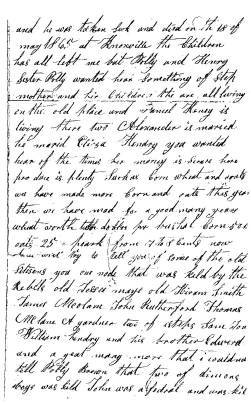
I can tell you that I have had a great deal of trouble since the commencement of the war we had hard times her threw the war. My boys all stayd home by scouting and hiding but my sone Barnard he went to the Federal army and volantiored in the serves of his country and he was taken sick and died on the 18 of may 1865 at Knoxville. . . .you wanted to hear of the times her. Money is scars here. Produce is plenty such as corn wheat and oates. Wee have made more corn and oates this year then wee have made for a good many years. weat worth two dollrs for bushel. corn 50 cents oates 25 poark from 7 to 8 cents now. Sara came by to tell you of some of the old sitisens you one node that was kild by the Rebels. old Jesse Mays old Hiram Smith James Mcolam Jaoh Rutherford Thomas Mclane A gardner two of esteps(?) Sons Jon William Hendry and his brother Edward and a great many more . . . tell Polly Brown that two of dimons boys was kild. John was a Fereral and was kild by the Rebels. Jim was a Rebel and was kild by the Federals. Jim was a bad boy for plundering and taking property. . . .I would wrote sooner if I had nown where to direct to. . . . The post oficises have been tore up so that wee never new where or who to write to.
Back to the review. Ms. Davis answers a question that worried me as I wrote Tempting Skies:
Can anyone read Tempting Skies and understand the characters without having read the previous two books? Definitely. Each character continues in their development with a quick, but not distracting background established in the previous books. By reading the third book first, I found myself wanting to know more about each person’s past when mentioned.
In the end, Ms. Davis concludes:
Tempting Skies is a brilliant novel revealing the day-to-day, unglamorous existence during the Civil War. Showing everyone has some losses during a war, the characters become realistic through Roueche while exploring the sites, smells, and sounds of Washington City in 1864, as well as the dangers.
Michael Roueche is a masterful storyteller creating a Civil War masterpiece in Tempting Skies.
Thank you, Teri, for your kind words.
The post Bestsellersworld.com Praises “Tempting Skies” appeared first on Michael J. Roueche.
December 23, 2016
“Tempting Skies” Recommended by “The US Review of Books”
 US Review of Books just awarded Tempting Skies its “Recommended” rating. “The recommended rating is used less than 10-20% of the time.” US Review says that recommended books of fiction “are compelling and lasting reads.”
US Review of Books just awarded Tempting Skies its “Recommended” rating. “The recommended rating is used less than 10-20% of the time.” US Review says that recommended books of fiction “are compelling and lasting reads.”
I’m grateful for the rating. I also want to thank the reviewer Dylan Ward for his thoughtful analysis.
You can check the review out at The US Review of Books website. I’ve also posted it with permission below, but changed the order–listing the criticism section before the summary–and added subheads.
(Note: If you haven’t read the first two books in the series, don’t read the summary yet. In fact, you may want to put off reading this summary till after you’ve read the book.)
Thanks again to Dylan and US Review.
Criticism

Roueche’s third installment in the Beyond the Wood Series completes a well-researched and interwoven narrative of the American Civil War. It once again demonstrates the award-winning author’s notable contribution to the genre. His novel, while at times complex, is nevertheless engaging and nothing is wasted. It boasts a large cast of characters who are all essential to the whole of the saga. Their strengths and weaknesses are portrayed in realistic light, each facing their own past in moments of trial and tribulation. As the novel nears its finale, surprising revelations encapsulate a tale of drama, romance, and suspense. Through it all, Roueche expertly highlights the plight of soldiers, discrimination, politics, and violence set against the backdrop of the waning days of a war-torn America. It is a worthy read.
RECOMMENDED by the US Review
Summary
“Coercion. Slavery. Freedom. Casualties. Deaths. Suffering. Starvation. Humiliation. She’d seen them all and was left not knowing what to want, what to believe, what to hope for, except for Hank and her child.”
It begins with the discovery of a “remarkable” manuscript that reveals events which occurred in the summer of 1864. During the tumultuous years of the Civil War, the manuscript depicts several lives that intersect amid a dangerous political landscape and the changing tide of a segregated society. Betsy Gragg, formerly Betsy Henderson, secludes herself in a Washington D.C. boarding house, haunted by her southern past. Her new husband, Henry Gragg, a member of the Union’s 19th Indiana Infantry, wills himself across the Virginia battlegrounds to reunite with Betsy and their unborn child. Actress, Anna Whitehead, falls victim to the cunning and murderous Lucius Walthorpe (a.k.a. Oskar Dante) who assumes the alias of Daniel Jefferson for his latest revenge plot against Betsy. Runaway slave, William Richman, finds himself in uncharted waters as a freeman while his wife, Victoria Richman, defies conventionalism as a nurse caring for wounded soldiers, becoming witness to the scars of war.
The post “Tempting Skies” Recommended by “The US Review of Books” appeared first on Michael J. Roueche.
December 13, 2016
“Midwest Book Review’s” Take on “Tempting Skies”
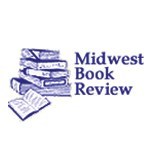 Midwest Book Review (MBR) included a look at Temping Skies, the final book in the Beyond the Wood series, in its December 2016 issue of Reviewer’s Bookwatch magazine.
Midwest Book Review (MBR) included a look at Temping Skies, the final book in the Beyond the Wood series, in its December 2016 issue of Reviewer’s Bookwatch magazine.
Here’s what MBR reviewer Jack Mason had to say–although I took the liberty of moving the Critique portion of the review ahead of the Synopsis and reformatted it a bit:
Critique
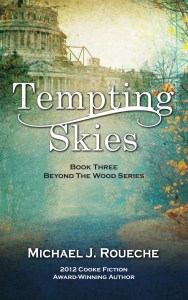
An impressively gifted storyteller, this concluding volume of a truly outstanding Civil War era trilogy by Michael J. Roueche is as extraordinary and consistently entertaining a read as his first two novels. While very highly recommended for community library Historical American Fiction collections, it should be noted for personal reading lists that Tempting Skies is also available in a Kindle format ($7.99), as are the first two volumes: Beyond The Wood (9780983756712, $17.99 PB, $4.99 Kindle) and A River Divides (9780983756767, $17.99 PB, $7.99 Kindle).
Synopsis
The third volume in Michael J. Roueche’s Beyond the Wood series, Tempting Skies is set some four decades after the conclusion of the American Civil War, and the former Kentucky slave, Victoria Richman, has passed away.
Among her belongings, her bereft family discovers a narrative she’s written recounting the summer of 1864 in Virginia and the Nation’s Capital. Mrs. Richman’s manuscript describes a defining year, full of fury, sorrow, dread, hate, hope and love in the lives that intersect hers:
Betsy Richman Henderson tries to escape once again her demoralizing dance with a still-scheming Lucius Walthrope, even as war’s devastation trudges southward toward her Shenandoah Valley homestead.
William Richman, at last a legally free man, painfully struggles to scrape away slavery’s emotional scars and remnant self-doubt. Amidst inner disarray and outer humiliation, he battles for his place in a new social order of liberty framed in 19th Century racism.
Victoria herself struggles to find meaning in her new life. Thoughtful and intelligent, she resists a mundane life far from the war and its shifting purpose as she lives and chronicles the dramatic climax of the Beyond the Wood Series.
The post “Midwest Book Review’s” Take on “Tempting Skies” appeared first on Michael J. Roueche.
November 23, 2016
“Ink and Fairydust Magazine” Interview
For its November/December issue, Ink and Fairydust Magazine interviewed me. Ink and Fairydust is an online, every-other-month publication that highlights the arts to “young Christians.”
Thanks to Courtney and all the folks at Ink and Fairydust for the interest and support. It comes at a perfect time with the release of Tempting Skies.
 Check out the interview.
Check out the interview.
The November/December issue also includes Christmas-focused poetry and short fiction. Enhance the season at Ink and Fairydust.
An Ink and Fairydust Excerpt
Here’s my answer to one question from the interview (Links and pictures added):
Who are some of your favorite authors and inspirations, and why do they inspire you?
A couple favorite, inspiring novels—neither interestingly were written in English—are Anna Karenina and Les Misérables.

Anna Karenina presents such a vivid contrast in the lives of those who make wise decisions and those who betray themselves and others with choices that cannot bring happiness. As I recall, after Tolstoy’s conversion to Christianity, he rejected all his earlier work, including Karenina. But I personally find much in it to support faith.

In Les Misérables, Victor Hugo creates an absorbing story and character of redemption, sacrifice, forgiveness and selflessness in Jean Valjean. Valjean is perpetually surrounded by self-serving, thoughtless creatures, yet after his “salvation,” he acts almost inexplicably to help those very self-serving, thoughtless creatures. Even as their inattention brings his premature death, he exhibits unwavering compassion and love. (A side note: Les Misérables was new and popular in the US during the Civil War. One of the despicable characters in A River Divides reads enough of the novel to lift an idea that enables him to continue his menacing ways.)

I’m also inspired by William Tyndale for his tireless and perilous work translating into English the Bible for the common man. I honor him for the dedication, talent and work that became the foundation and much of the substance of the great artistry of the King James Bible and, I suppose, helped “open the King of England’s eyes.” And if you think about Tyndale’s great influence on the English language, you have to note William Shakespeare. A few years ago and stemming from a personal goal, I read and blogged about all of his plays and poems (many for the first time). The beauty of the language he created and his spot-on insights into the human soul are just as real and relevant today as they were four centuries ago, as is his influence on our day-to-day language. I was so moved by my Shakespeare experience that I included a Shakespeare-loving English soldier in soon-to-be-published Tempting Skies.
The post “Ink and Fairydust Magazine” Interview appeared first on Michael J. Roueche.
November 1, 2016
Announcing “Tempting Skies”
Yesterday, Vesta House Publishing announced release of Civil War novel “Tempting Skies”:
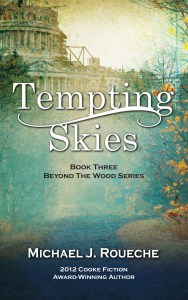
Bountiful, Utah (October 31, 2016) — Vesta House Publishing is pleased to announce publication of Tempting Skies, Book Three, Beyond the Wood, by international-award-winning author Michael J. Roueche.
The 368-page novel is the final book in the historical fiction series set in the American Civil War.
Four decades after the Civil War, former Kentucky slave Victoria Richman has passed away. Among her belongings, her bereft family discovers a narrative she’s written recounting the summer of 1864 in Virginia and Washington City. Mrs. Richman’s manuscript describes a defining year in the lives that intersect hers:
• Betsy, a Southern sympathizer stranded in Washington City, tries to escape a scheming sociopath, even as the war’s devastation trudges southward toward her Shenandoah Valley homestead.
• William Richman, at last a legally free man, painfully struggles to scrape away slavery’s emotional scars and remnant self-doubt. Amidst inner disarray and outer humiliation, he battles for his place in a new social order of liberty framed in 19th-Century racism.
• Victoria struggles to find meaning in her new life. Thoughtful and intelligent, she resists a mundane life far from the war and its shifting purpose as she lives the climax of the trilogy.
“War, romance and mystery collide in this deeply researched Civil War novel,” proclaimed the Denver Post of the first book in the series, Beyond the Wood.
The initial installment recounts the story of Betsy struggling with burdens left by the death of her Confederate soldier husband and the conspiracy of neighbors. At the same time, she becomes the obsession of a Union soldier who imagines a romance that drives him relentlessly toward an impossible rendezvous with her. The 514-page novel was recipient of the 2012 John Esten Cooke Award for Civil War and Southern history.
Midwest Book Review “highly recommended” the second in the series, A River Divides. It called the book “a sober, thoughtful, and expertly researched Civil War novel.” The work was selected Drama Category Winner, Laramie Awards for Western, Pioneer and Civil War fiction.
The 395-page novel begins in the winter of 1864 as Eastern Theater soldiers languish in camp boredom, and conspiracy and treachery envelop Betsy. Meanwhile, her family’s runaway slave William, craving his chance to fight for the Union, flees Virginia, stumbling into the murky waters of Kentucky servitude.
Michael J. Roueche grew up in Virginia and spent most of his life in the Old Dominion. He holds degrees from Brigham Young University and Virginia Tech and spent many years in corporate communications. He and his wife of 40 years currently reside in Colorado. They have five kids and several grandchildren.
The post Announcing “Tempting Skies” appeared first on Michael J. Roueche.
October 19, 2015
Roll, Jordan, Roll: A Book Review
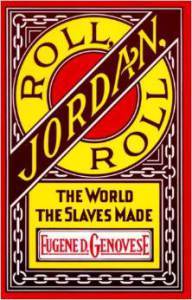
A self-professed communist, who got kicked out the Communist Party, included his Marxist viewpoint of American slavery in “Roll, Jordan, Roll.”
Roll, Jordan, Roll, The World the Slaves Made, winner of the 1975 Bancroft Prize, is indispensable to understanding American slavery in the antebellum South. It’s also delightfully controversial in history and content.
It was written by Eugene D. Genovese , a communist later turned conservative. He was in his Marxist phase when he wrote it, and he tried to squeeze his image of slavery into his perspective of ideological class conflict and exploitation. I found his communist theorizing for the most part easy to ignore, though tedious at times, but I appreciated his comparisons of slaves in the Old South with workers and slaves and their circumstances around the world. Some readers, however, thought his social theories devalued Roll, Jordan, Row.
Roll, Jordan, Roll: A Theory of Paternalism
Other reviewers have complained Genovese wrote of slavery as one Goodreads reviewer claims focusing “on slavery as a system of paternalism. It tries hard but in its efforts reduces slaves to one dimensional caricatures who have bought into and welcome the system of slavery.” I can’t imagine we’re thinking of the same book.
But it’s not just casual reviewers have who disputed the book’s perspective: In its obituary for the author, the New York Times noted “historian Edward L. Ayers . . . called it ‘the best book ever written about American slavery'” while historian Eric Foner held that “the buying and selling of slaves could hardly be considered paternalistic; parents do not normally sell their children.”
Sounds to me like a semantic disagreement.
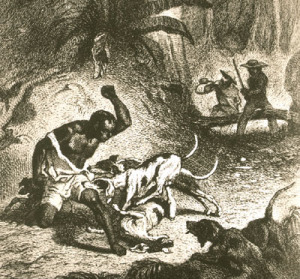
“Row, Jordan, Row” notes specially trained dogs, often owned by poor whites, tracked runaways, maiming and killing if not pulled quickly from the escaping slaves.
Genovese does write extensively in Roll, Jordan, Roll about paternalism but never suggests slaves bought into or welcomed the abominable social order or system. There was never a doubt in my mind that the complete wrongness of slavery in all its forms under-girded Genovese intent and work in the book. To me Roll, Jordan, Roll did exactly the opposite of what such detractors claim. It portrays a range of slaves and slave experiences, always presenting the victims as individual human beings under unbearable circumstances. His major premise is slaves individually and collectively created meaningful lives and community, stubbornly refusing to adopt slaveholder will as their own. As Genovese writes:
Slavery, a particularly savage system of oppression and exploitation, made its slaves victims. But the human beings it made victims did not consent to be just that; they struggled to make life bearable and to find as much joy in it as they could. Up to a point even the harshest of masters had to help them do so. The logic of slavery pushed the masters to try to break their slaves’ spirit and to reconstruct it as an unthinking and unfeeling extension of their own will, but the slaves’ own resistance to dehumanization compelled the masters to compromise in order to get an adequate level of work out of them.
In this quote, I hear criticism of slaveholders and their dehumanization of slaves in their pursuit of wealth—a legitimate attack on the capitalism of the antebellum past North and South which conspired against Africans stolen from their homelands. In no sense does the quote above, which captures the spirit of the tome, hold that slaves approved of or passively accepted their state. When the author wrote about slave revolts (or lack of them), he reprises the theme:
In the United States those prospects [of revolting], minimal during the eighteenth century, declined toward zero during the nineteenth. The slaves of the Old South should not have to answer for their failure to mount more frequent and effective revolts; they should be honored for having tried at all under the most discouraging circumstances.
As time went on those conditions became steadily more discouraging: the hinterland filled up with armed whites; the population ratios swung against the blacks; creoles [I believe he uses creole in the sense of American born] replaced Africans; and the regime grew in power and cohesion. . . . Meeting necessity with their own creativity, the slaves built an Afro-American community life in the interstices of the system and laid the foundations for their future as a people. But their very strategy for survival enmeshed them in a web of paternalistic relationships which sustained the slaveholders’ regime despite the deep antagonisms it engendered.
The slaves’ success in forging a world of their own within a wider world shaped primarily by the oppressors sapped their will to revolt, not so much because they succumbed to the baubles of amelioration as because they themselves were creating conditions worth living in as slaves while simultaneously facing overwhelming power that discouraged frontal attack.
Neither quote suggests to me a view of slaves as willing, docile human beings accepting happily their state, willingly ceding their independence and will to the slaveholder. But the author also is not presenting a simplistic view of slavery that offers all slaves as heroes and all slave owners as despotic. In his work, Genovese portrays a complex system where players (some better than others) by choice and others without choice work for their own purposes, exacting as much as they can from the other side.
Roll, Jordan, Roll depicts slaveholders consciously manipulating the feelings and loyalties of their slaves to their own purposes. Included in those manipulations is granting “privileges” as one-time “gifts” to slaves, but the slaves successfully seized many such privileges, claiming them as rights for the future, thus bettering as best they could their living conditions. Over time, this give and take developed into recognized, “accepted” traditions. Thus “masters had the upper hand, but slaves set limits as best they could” in a series of horrible compromises. Such a view seems consistent with the complexity of all human relations and therefore appears credible.
Clearly, however and unfortunately, both master and slave consciously or unconsciously bought into a paternalistic relationship and strengthened it by their respective behavior based on masters generally taking responsibility for clothing, feeding and protecting (not necessarily well) and slaves coming to expect it. This led to some slave owners believing their own propaganda and feeling betrayed by the “lack of gratitude” slaves showed when they would run away or had the audacity to leave the plantation or farm after the war or Union army freed them.
Varied Voices
For me, the best aspect of Roll, Jordan, Roll was Genovese’s use of quotes from slaveholders and slaves across the wide array of topics covered, offering varied voices and circumstances to create a broader, more textured understanding of the state of slavery in the South.
I also appreciated the book’s discussion of the development of an ironic style of communication among slaves. They didn’t have the freedom to speak the truth so they developed the ability to speak “undercover,” saying at times the opposite of what they meant. Roll, Jordan, Roll never gives us a stereotypical slave as fool, while it does capture slaves sometimes playing the fool to manage masters, some of whom understood and at times appreciate the theater and some who become the fools by not recognizing the manipulation.
Another appreciated aspect of Roll, Jordan, Roll was revelation of the flexibility of the slave work calendar. Sometimes we’re left with the impression slaves were worked 14-16 hours a day constantly for years on end, always leaving one wondering how they could survive. That was the lot of some slaves in other countries in the hemisphere where they were literally worked to death. But in the American South, master self-interest meant slaves generally were not required to work such long hours in all weather conditions year round. During specific seasons and activities, such as cotton harvest, they did labor exceptionally long days. But that was, Genovese suggests, the exception. That’s not to imply slave life was pleasurable because of a “shortened” work day as forced labor and hours are wrong and miserable on any scale. But it presents a more realistic perspective on work hours.
Roll, Jordan, Roll is dense, long (nearly 700 pages; over 800 with notes) and complicated. It covers a wide expanse of topics, including religion, law, work and work conditions, freedmen, mammys, runaways, love, sex, drivers and overseers, marriage, the elderly, children, cooking and funerals. (Researching the last topic is why I picked up the book in the first place.) Necessarily some topics aren’t covered in as much depth as I would have liked. But the book is a major accomplishment and a unique contribution to our understanding of the world the slaves made. In the end it is an indispensable tribute to what slaves were able to achieve in spite of being forced to play a rigged game of chance.
Mr. Genovese great labor enriched my understanding of the awful institution of slavery in the South.
Nod to transparency: Some members of my family descend from slaves held in the US and one family of ancestors held—based on census records—two slaves, a young woman and a boy under 10.
The post Roll, Jordan, Roll: A Book Review appeared first on Michael J. Roueche.
June 16, 2015
Teaching with Living History in Schools: An Interview with Educator Kurt Knierim
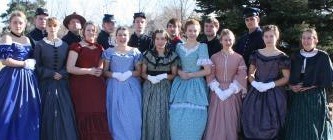
Lobo Mess, a Civil War living history club at Rocky Mountain High School in Ft. Collins. Photo by Joyce Bryant.
Several years ago, we attended a Civil War living history reenactment in Colorado. One highlight of the event was meeting a group of young women in period attire who we learned were students of Kurt Knierim, a social studies teacher from Rocky Mountain High School in Ft. Collins. They were also members of the school’s Civil War Living History Club dubbed Lobo Mess. (Lobo for the school mascot and mess for Civil War soldiers who ate together.)
I’ve been thinking about the impact living history has on young people of late, so I reached out to interview Knierim to get his insights from using living history to teach and motivate students.
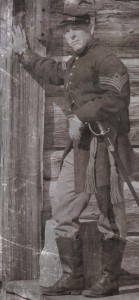
Kurt Knierim, award-winning educator, poses in uniform. Photo courtesy of Sean Papile.
As background, Knierim has been teaching at Rocky Mountain since 1992 and holds an honorarium faculty appointment in the history department at University of Colorado at Denver. He majored in history at Colorado State University and has earned Master’s degrees in education and American History. He was the 2010 Gilder Lehrman Institute for American History Teacher of the Year for Colorado. Not surprisingly, he also teaches “Secondary Social Studies Methods” for the History Department at Colorado State University.
Knierim’s Lobo Mess according to the school website is a “Civil War Living History independent study class…that allows high school students to take an active role in and present Civil War era living history.” It’s made presentations before “well over 10,000″ people” at “elementary schools, civic organizations, home school groups, television, museums, national parks, Colorado state parks, parades and battle reenactments.”
Where did you come up with the idea of getting students dressed in period clothes to do living history presentations?
I started participating in living history in 1997. From the beginning I was asked to visit schools and do presentations. By 2002, I had accumulated enough uniform parts to cobble together a second uniform. With uniform in hand, I asked one of my high school students to accompany me to a presentation at McGraw Elementary School. In preparation for the school visit, I taught the student the basics of the School of the Soldier and thus began what would become the Lobo Mess.
What’s the School of the Soldier, and what do you include in yours ?
It was the “basic training” that was included in the first part of every drill manual from the period. I use a blend of Hardee’s 1855 manual as well as Casey’s 1862 manual. I feel it is important for the students to be proficient at the basics of drill because it allows them to function as soldiers and affords them opportunities to “fall in” with other groups.
(Note: William Joseph Hardee resigned from his post at West Point to join the Confederacy at the beginning of the Civil War. His tactics manual was used by both sides during the war. The Hardee Hat, named for the General, was also used by both sides, most famously by the Union’s Iron Brigade. Silas Casey was a Union general during the war. Both were career military men.)
What difference has your approach made?
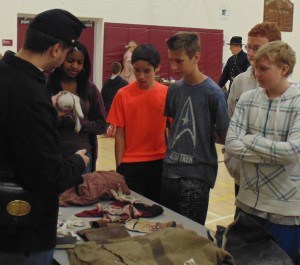
A Lobo Mess member explains Civil War paraphernalia to middle school students. Photo by Gabrielle Wymore.
There are three benefits I have seen with the club.
First, the club is students presenting to students. There are not many other models of clubs besides maybe “reading buddies” that pair students with students to teach and learn.
Second, it has produced public speaking confidence for the members of the Mess. It is wonderful to see the transformation from rather shy students who love history into young adults that don’t think twice before presenting to upwards of 100 students at a time.
Third, it provides students a way to experience history in ways they would not be able to in the regular classroom setting. By digging into research and “living out” their research, they gain knowledge and skills they will never forget.
What kind of feedback do you get from the club and living history?
Students seem to love it. I regularly have former “Messers” inquire about presentations, “crash” weekly meetings, and show up to events even years later.
In December (2014), current members of the “Mess” attended a Civil War ball–sponsored annually by the First Colorado Volunteer Infantry—in Denver. In addition to my current Messers, five others showed up, some having graduated as long ago as 2010.
Parents get so excited about it they sometimes tag along to presentations to see their kiddos in 1860s action.
The community has also been supportive. For the last six summers, we have partnered with the Fort Collins Discovery Museum (Local History Museum) to present for their “Wild West Days” summer program. In addition, the local history group, the Westerners, has invited us to present a couple times at their meetings. It’s also donated several hundred dollars to the club almost every year.
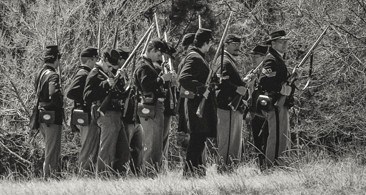
“Messers” join maneuvers near Red Rocks in Colorado. Photo courtesy of Stuart Lawrence.
We’re a long way from most reenactments. Do you get a chance to take students to very many reenactments?
We are a four-year high school, so I try to take a trip to a larger reenactment once every four years. Although we have gone as far as West Virginia (Battle of Rich Mountain), we usually head South to the Glorieta Pass reenactment near Santa Fe New Mexico in early May. I have also taken students to several NPS and State historic sites to do living history weekends.
How do these trips impact students?
Students get really excited about them. It really encourages them to stick with the hobby or even study history after high school.
One example would be Jim Bertolini who graduated in 2005. He continued to do living history for a number of years after high school and now has a Master’s in history. He currently is a historian in the State Historic Preservation Office for all of Nevada.
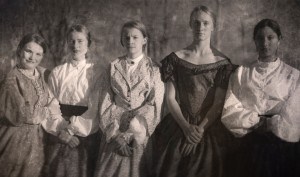
Club members, left to right, Ayrika Johnson, Monica Stauffer, Elle Chaffee, Katrin Sharpe and Nisa Rubio portray civilian ladies in photo taken by Lobo Mess member Sean Papile.
Tell us about what you personally do for the living history club.
I sponsor the club, which includes bringing in guest speakers and leading weekly meetings. I also aid the students in scheduling presentations, doing research for their presentations and arranging transportation to and from presentations and events.
What are your/their biggest obstacles?
We are always strapped for cash. We have more interest than ability to outfit students. Although we have a solid pool of material culture (9 infantrymen, 3-4 male civilians, and 7 ladies), there is always an issue of not having the right size of something or having to turn folks away because we cannot outfit them. Another obstacle is time. I always get many more requests for presentations than we have time for.
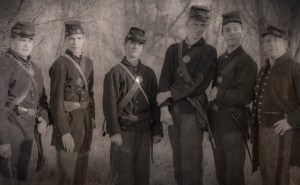
The soldiers of Lobo Mess, from left to right, Ben Colon-Bonet, Ryan Bolander, Nick AmRhein, Logan Haas, Bjorn Swenson and Kurt Knierim pose for a unit photo. Photo used by courtesy of Sean Papile.
How have you changed your approach over the years?
I have given over more and more to student leadership. Partly for practical reasons, and partly to build leadership. We also have every member put together at least one 10-15 minute “station” of interactive information to share at presentations.
Does this approach appeal only to students already interested in history, or do you attract students “new to history” as well?
We get all types. That is another strength of the club. We have the high flying AP crowd as well as the kids on Individualized Education Programs (IEP). This is great for the kiddos to have to get to know and work with students they would not ordinarily rub elbows with. Participating students are generally interested in the history, the material culture or the acting part of it.
Has interest and popularity of the class increased over time?
Yes, we have gone from one student to an average of about 15. Our biggest year, we had 20 and I had to turn kids away.
Are others picking up your approach?
I have had interest here and there, but without substantial monies for outfitting folks, there is not much chance of a club like this getting off the ground.
I’m sure it’s also crucial to have a dedicated teacher involved as well. Thanks Kurt Knierim. We hope your program continues to flourish and look forward to seeing you and your students at future living history reenactments.
The post Teaching with Living History in Schools: An Interview with Educator Kurt Knierim appeared first on Michael J. Roueche.



